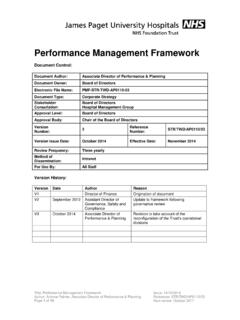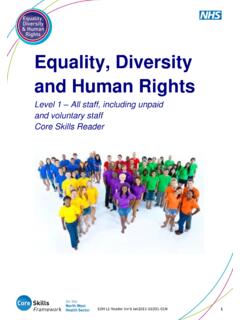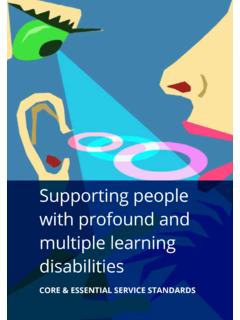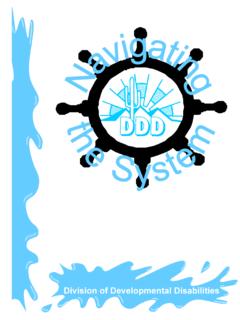Transcription of Communicating with people with profound and multiple ...
1 Your guide to Communicating with people with profound and multiple learning disabilities (PMLD). About this guide This guide is an introduction to Communicating with people with PMLD. It explains how people with PMLD communicate and gives examples of some of the non-formal communication methods which people can use when working with people with PMLD. It also contains useful information about additional resources and support that are available. Look for the what next ' sign for things you can do. Contents Communicating with people with profound and multiple learning disabilities (PMLD) 4. What does PMLD mean? 5. What is communication? 6. How do people with PMLD communicate? 7. Different ways of Communicating with people with PMLD 8. The best environments in which to communicate 12. Top tips for Communicating with people with PMLD 13. Further help 14. Contacts 16. 4 | Communicating with people with profound and multiple learning disabilities (PMLD).
2 Communicating with people with profound and multiple learning disabilities (PMLD). Many people with profound and multiple learning disabilities (PMLD) do not communicate using formal communication like speech, symbols or signs. But this does not mean that they can't communicate. She communicates through hand gestures, making noises and facial expressions.. people communicate in many different ways and we need to make sure that everyone's way of Communicating is valued. However, parents and professionals have told us that the communication needs of people with PMLD are often not being met, as many people supporting and working with people with PMLD don't understand how they communicate. | 5. What does PMLD mean? All children and adults with PMLD need high levels of support with most aspects of daily life. people with PMLD: have more than one disability have a profound learning disability have great difficulty Communicating need high levels of support with most aspects of daily life may have additional sensory or physical disabilities , complex health needs or mental health difficulties may have behaviours that challenge us.
3 Read the PMLD Network definition of profound and multiple learning disabilities at Find out about Meet the people ' - a CD-ROM which introduces you to six people with PMLD at 6 | Communicating with people with profound and multiple learning disabilities (PMLD). What is communication? Communication is: the way we control our lives the way we make friends the way we become independent the way we make choices the way we express our feelings, thoughts and emotions two-way. He is learning to show that he wants to carry on with an activity, and to realise that he can have control over what happens.. | 7. How do people with PMLD. communicate? Many people with PMLD do not use formal communication, such as speech, symbols or signs. Instead they tend to rely on facial expressions, vocal sounds, body language and behaviour to communicate. Some people with PMLD. may not have reached the stage of using intentional communication, and they may rely on others to interpret their reactions to events and people .
4 It is important that those who support people with PMLD spend time getting to know their means of communication and finding effective ways to interact with them. There are different non-formal techniques and approaches that can be used to help interpret the needs and choices of people with PMLD. All staff and family members should be supported to use these techniques and approaches. She has an advocate who spends time with her learning how she communicates and the things she likes.. 8 | Communicating with people with profound and multiple learning disabilities (PMLD). Different ways of Communicating with people with PMLD. There are a number of different ways of Communicating with people with PMLD in everyday life. Remember that everyone is unique, so it is good to explore different ways of Communicating what works for one person might not work for someone else. 1. Using objects of reference These are objects that have special meanings attached to them.
5 They are useful for people who are unable to understand pictures or symbols. They can help someone to understand what is being discussed or to anticipate an event or activity. To help make an object meaningful to the person you support it can be useful to present the object and follow it straightaway with the activity it represents for example presenting a cup and then following it by giving the person a drink. Once a link has been made between the object and an event or activity, the object can start to represent that activity. If objects of reference are developed for different activities then they might provide a way for someone to get involved in choosing what they want to do. To make an object of reference, think about an item that could be linked to an activity that the person you support does regularly, like shopping. Think of creative ways for example using sound and smell that you can use to help make a link between that object and the activity.
6 Then see if the person associates that object with the activity. Try it with other activities too, and try using objects of reference with the person to help plan and choose what activities they want to do. Visit the Total Communication website at | 9. 2. Use of appropriate communication aids Many communication aids are not appropriate for people with PMLD, for example, voice recognition software. However, a Big Mack is an example of a communication aid which can help someone with PMLD. communicate. It is a simple, one-message communication device, which allows a single message of up to 20 seconds to be recorded and played back and is activated at the push of a button. You can record a noise on a Big Mack and stick pictures on it or attach an object to it to help prompt the person to use it. The person can then communicate and get involved by pressing the Big Mack and activating the message or sound.
7 She really enjoyed making her videos and having her photo taken.. The use of video and digital photography to show how someone communicates is also being used more as a communication aid. It gives people with PMLD the opportunity to show people how they communicate via film or photos. It also gives them the opportunity to share other things about themselves, for example, what they like doing. Find out more about communication aids on the Liberator website at 3. Intensive interaction Intensive interaction involves quality one-to-one time between a teacher or support worker and the student. It teaches the pre-speech fundamentals' of communication or communication before language. It can also be used simply as a meaningful way of being with someone. Intensive interaction simply involves the person with a learning disability and a partner who should be quite sensitive. Together they progress through relaxed, enjoyable, interactive sequences.
8 10 | Communicating with people with profound and multiple learning disabilities (PMLD). The style of intensive interaction is very much one of exploratory play and involves validating the person's own ways of engaging with the external world and their body. It is a sensitive and respectful way of interacting with someone. If you are interested in this technique, you should spend some time thinking about how the person you support engages with the outside world and their body. Intensive interaction is about sharing someone's world and Communicating with someone on their terms, in a way that is meaningful to them, in their language. Read the Mencap factsheet PMLD and Intensive Interaction'. at Visit the Intensive Interaction website at 4. Communication passports A communication passport presents the person positively as an individual. It draws together information from past and present, and from different contexts, to help staff and conversation partners understand the person, and have successful interactions.
9 It is a place where the person's preferences can be recorded. The person's preferred means of Communicating is also recorded some innovative practice uses digital film. A communication passport is a very useful way to help others understand how someone communicates. Use or adapt Scope's template for a child's communication passport at Read guidelines for good practice around creating and using personal communication passports at | 11. 5. Use of multimedia Using video and digital photography to develop computer-based personal profiles has helped people with PMLD to have a voice' and put across their preferences in a really powerful way. It is an approach that is being used more and more. To start using multimedia, you could take some film of the person you support doing an activity they enjoy. See how they respond to being filmed and to watching film of themselves. Do you think the film is useful in showing how the person communicates and what they enjoy doing?
10 It is always important to think about issues around consent when you are filming someone or showing people 's images. For more information read Mencap's factsheet on consent for video and photographs at She is part of a multi-media profiling project. She can use it to communicate with staff when they watch it with her they can learn about the things she likes, how she communicates and how she likes to be supported.. Find out about Meet the people ' CD-ROM and see how useful film can be to help people understand how people with PMLD communicate at Read the Mencap Factsheet PMLD - multimedia profiling'. Visit the Acting Up website for more information about multimedia profiling at 12 | Communicating with people with profound and multiple learning disabilities (PMLD). The best environments in which to communicate Many people with PMLD experience the world largely on a sensory level. Multi-sensory environments Multi-sensory environments which tune into the senses can be great environments for developing someone's communication skills.








